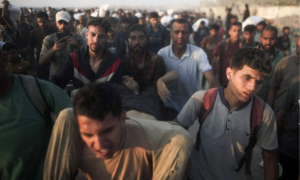‘The Hunger Games’: Inside Israel’s aid death traps for starving Gazans

Palestinians carry away a wounded man hit by Israeli fire while trying to get food aid on Al-Rashid Street, near the Netzarim Corridor, 16 June 2025
Ahmed Ahmed and Ibtisam Mahdi report in +972 on 20 June 2025:
In the early hours of June 11, before sunrise, 19-year-old Hatem Shaldan and his brother Hamza, 23, went to wait for aid trucks near the Netzarim Corridor in the central Gaza Strip. They hoped to return with a bag of white flour for their family of five. Instead, Hamza returned with his younger brother’s body wrapped in a white burial shroud.
The Shaldan family had lived virtually without food for nearly two months due to Israel’s blockade, crammed into a classroom-turned-shelter in eastern Gaza City. Their home, once nearby, was destroyed completely by an Israeli airstrike in January 2024.
At around 1:30 a.m., the two brothers joined dozens of starving Palestinians on Al-Rashid Street along the shore upon hearing that trucks carrying flour would enter the Strip. Two hours later, they heard shouts of “The trucks are coming!” followed immediately by the sound of Israeli artillery shelling.
“We didn’t care about the shelling,” Hamza recounted to +972 Magazine. “We just ran toward the trucks’ lights.” But in the chaos of the crowd, the brothers got separated. Hamza managed to grab a 25kg bag of flour. When he returned to their agreed-upon meeting spot, Hatem wasn’t there.
“I kept calling his phone, over and over, without answer,” Hamza said. “My heart ached. I began seeing dead bodies being carried over to where I was. I refused to believe my brother might be among them.”
Hours after Hatem went missing, Hamza received a call from a friend: a photo of an unidentified body had surfaced in local Whatsapp groups, taken at Al-Aqsa Martyrs Hospital in Deir Al-Balah, central Gaza. Hamza sent a cousin — a tuk-tuk driver — to check. “Half an hour later, he called back, his voice shaking. He told me it was Hatem.”
Upon hearing this, Hamza passed out. When he came to, people were pouring water on his face. He rushed to the hospital, where a man wounded in the same artillery strike explained what had happened: Hatem and about 15 others had tried to hide in tall grass when Israeli tanks opened fire.
“Hatem was hit by shrapnel in his legs,” the man said. “He bled for hours. Dogs circled them. Eventually, when more aid trucks arrived, people helped move the bodies onto one of them.”
In total, 25 Palestinians were killed that morning waiting for aid trucks on Al-Rashid Street. Hamza brought Hatem’s body back to Gaza City and buried him beside their mother, who was killed by an Israeli sniper in August 2024. Their older brother, Khalid, 21, had died months earlier — in a January airstrike while evacuating wounded civilians on his horse cart.
“Hatem was the light of our family,” Hamza said. “After we lost our mother and Khalid, he became everyone’s favorite — including my grandmother and aunts. He visited them and helped them. My grandmother collapsed when she saw his body. She still weeps.”
Hatem had been a skilled car accessories technician with dreams of opening his own shop. “He was kind and generous and loved children; he always gave them sweets,” Hamza said. “Everyone who knew him came to his funeral. May God hold the occupation accountable for stealing our lives, just because we are from Gaza.”
Near-daily massacres
As the world’s attention turns to the war between Israel and Iran — and with Israel simultaneously cutting off internet and telecommunications services, imposing effective media and information blackouts on millions of Palestinians — Israel’s attacks on starving Gazans awaiting aid have only intensified.
